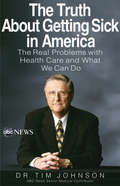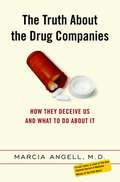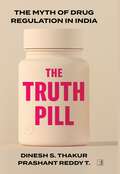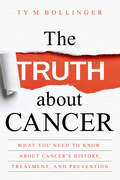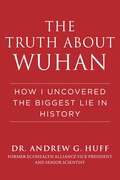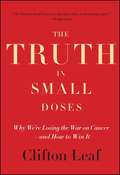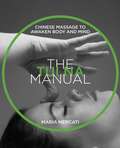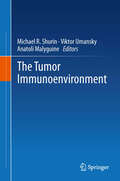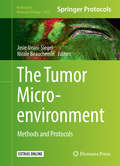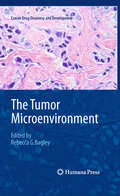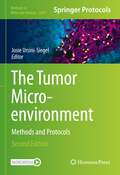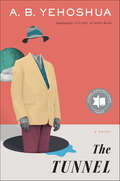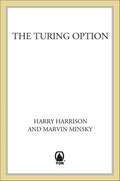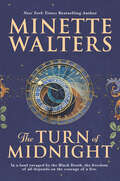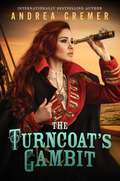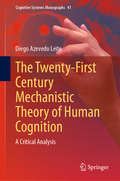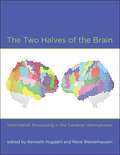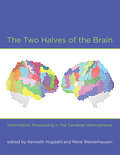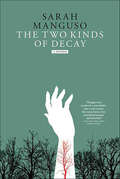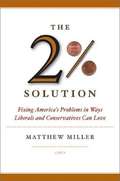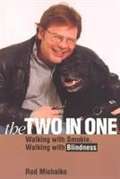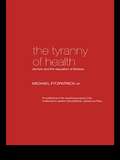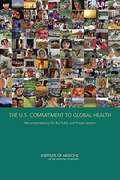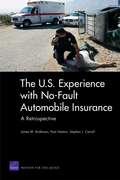- Table View
- List View
The Truth About Getting Sick in America: The Real Problems with Health Care and What We Can Do
by Tim JohnsonIn today's world, there are many hot-button topics that generate equal parts debate and confusion. At the top of that list is healthcare. For most Americans, finding out "the truth" about current problems or possible fixes is virtually impossible amidst all the emotionally charged rhetoric. Dr. Tim Johnson has been reporting on health matters for ABC since the mid-seventies, but in recent years he has spent an increasing amount of time studying our system of healthcare--or lack thereof. Many Americans fall between the cracks and do not receive any care--or receive care that is either inferior or too costly or both. Over the years, he has learned some important lessons, and in The Truth About Getting Sick in America, he shares those lessons and looks to the future of American healthcare.
The Truth About the Drug Companies: How They Deceive Us and What to Do About It
by Marcia AngellDuring her two decades at The New England Journal of Medicine, Dr. Marcia Angell had a front-row seat on the appalling spectacle of the pharmaceutical industry. She watched drug companies stray from their original mission of discovering and manufacturing useful drugs and instead become vast marketing machines with unprecedented control over their own fortunes. She saw them gain nearly limitless influence over medical research, education, and how doctors do their jobs. She sympathized as the American public, particularly the elderly, struggled and increasingly failed to meet spiraling prescription drug prices. Now, in this bold, hard-hitting new book, Dr. Angell exposes the shocking truth of what the pharmaceutical industry has become–and argues for essential, long-overdue change.<P> Currently Americans spend a staggering $200 billion each year on prescription drugs. As Dr. Angell powerfully demonstrates, claims that high drug prices are necessary to fund research and development are unfounded: The truth is that drug companies funnel the bulk of their resources into the marketing of products of dubious benefit. Meanwhile, as profits soar, the companies brazenly use their wealth and power to push their agenda through Congress, the FDA, and academic medical centers.<P> Zeroing in on hugely successful drugs like AZT (the first drug to treat HIV/AIDS), Taxol (the best-selling cancer drug in history), and the blockbuster allergy drug Claritin, Dr. Angell demonstrates exactly how new products are brought to market. Drug companies, she shows, routinely rely on publicly funded institutions for their basic research; they rig clinical trials to make their products look better than they are; and they use their legions of lawyers to stretch out government-granted exclusive marketing rights for years. They also flood the market with copycat drugs that cost a lot more than the drugs they mimic but are no more effective.<P> The American pharmaceutical industry needs to be saved, mainly from itself, and Dr. Angell proposes a program of vital reforms, which includes restoring impartiality to clinical research and severing the ties between drug companies and medical education. Written with fierce passion and substantiated with in-depth research, The Truth About the Drug Companies is a searing indictment of an industry that has spun out of control.
The Truth Pill: The Myth of Drug Regulation in India
by Dinesh Singh Thakur Prashant Reddy ThikkavarapuSince 2004, when the fraud at Ranbaxy, the largest Indian pharmaceutical company at the time first came to light, the Indian pharmaceutical industry and clinical research organizations have been rocked by a series of scandals after investigations by American and European drug regulators. While the West has responded to concerns about quality of &“Made in India&” medicine by blocking exports from many Indian pharmaceutical companies, the Indian government responded not with regulatory reform but conspiracy theories about &“vested interests&” working against India. More worryingly, the Indian state has also turned a blind eye to a far more serious quality crisis in its domestic pharmaceutical market. At times, these quality issues manifest themselves in the deaths of Indian citizens as happened in early 2020 when 11 children died in Jammu because of adulterated cough syrup. On other occasions, a dodgy drug approval process has led to the Indian regulator approving sales of drugs that have never been approved by regulators in the developed markets. The result is not just poor health outcomes but outsize profits for pharmaceutical companies manufacturing medicines that have never been validated through scientifically rigorous clinical trials for therapeutic evidence. These twin crises, in both the domestic and export markets, is because India has either outdated regulations or no regulations in some areas. Even the outdated regulations are enforced with kids gloves by drug inspectors and judicial magistrates who are ready to forgive even those whose drugs are found to contain barely any active ingredient or dangerously high levels of bacterial endotoxins. In a race for growth of the pharmaceutical industry, the Indian state has sacrificed scientific rigour and ignored the basic principles of public health. Given India&’s position as the pharmacy of the developing world, the failure of the Indian state is a problem for not just India but most of the developing world. This timely, important and compelling book based on deep research, questions and analyzes the actions of the institutions that are responsible for the safety and efficacy of the Indian drug supply in the context of the historical evolution of the Drugs Act 1940 from pre-Independence India to the present day. The future of Indian public health lies in responding to the issues raised in this book.
The Truth about Cancer: What You Need to Know about Cancer's History, Treatment, and Prevention
by Ty M. BollingerCancer touches more lives than you may think. According to the World Health Organization, one out of three women alive today, and one out of two men, will face a cancer diagnosis in their lifetime.To Ty Bollinger, this isn’t just a statistic. It’s personal. After losing seven members of his family to cancer over the course of a decade, Ty set out on a global quest to learn as much as he possibly could about cancer treatments and the medical industry that surrounds the disease. He has written this book to share what he’s uncovered —some of which may shock you —and to give you new resources for coping with cancer in your life or the life of someone you love.As Ty explains, there are many methods we can access to treat and prevent cancer that go well beyond chemotherapy, radiation, and surgery; we just don’t know about them. The Truth about Cancer delves into the history of medicine —all the way back to Hippocrates’s credo of "do no harm" —as well as cutting-edge research showing the efficacy of dozens of unconventional cancer treatments that are helping patients around the globe. You’ll read about the politics of cancer; facts and myths about its causes (a family history is only part of the picture); and the range of tools available to diagnose and treat it.If you’re facing a cancer diagnosis right now, this book may help you and your health-care provider make choices about your next steps. If you’re already undergoing conventional treatment, it may help you support your health during the course of chemo or radiation. If you’re a health-care provider and want to learn all you can to help your patients, it will expand your horizons and inspire you with true stories of successful healing. And if you just want to see cancer in a new light, it will open your eyes.
The Truth about Wuhan: How I Uncovered the Biggest Lie in History
by Dr. Andrew G. HuffShocking new insider information that shows what really happened in Wuhan, China, at the start of the COVID-19 outbreak and in the ensuing cover-up. The day that Dr. Andrew G. Huff left his senior scientist and vice president role at EcoHealth Alliance was one of the happiest days of his life due to the corruption he had witnessed at the organization. However, he never thought working there would be of any great consequence to the future. He was wrong. Because, as an EcoHealth Alliance insider, Dr. Huff had had a ringside seat to one of the biggest cover-ups in history. The Truth about Wuhan contains new research and a breakdown of how and why the development of COVID-19 in the United States and China was supported by the US government to collect intelligence on laboratories in China. Dr. Huff, an expert in the fields of bioterrorism and bio warfare, is a whistleblower who will show why the reasons the lab leak was covered up are incorrect. He worked on the classified research side of the program as a US government scientist. He knows the real how and why COVID-19 emerged. Besides exposing the conspiracy and cover-up, Dr. Huff also puts forth policy solutions and recommendations to prevent a lab leak virus from plaguing the world again. The Truth about Wuhan simply explains the complexity of the system that led to COVID-19&’s emergence; how the medical industrial complex grew and became entrenched in gain of function work after 9/11; why EcoHealth Alliance was the (almost) perfect intelligence collection cover; the policy actions and decision-making process as to why the United States government engaged in the COVID cover-up; how and why the United States swapped biotechnology with China and biomedical corporations; and the incentives for each of the actors or governments to engage and coordinate a global cover-up of COVID-19 origins. The Truth about Wuhan also shows how and why Dr. Anthony Fauci is intricately involved in the COVID cover-up; how scientists like EcoHealth Alliance president and CEO Dr. Peter Daszak rose to power and used their influence to corrupt science and the COVID origin investigation; and how the intelligence community likely orchestrated the cover-up with Dr. Anthony Fauci. Dr. Huff also provides personal harrowing accounts of how the US government waged a psychological operation against him to prevent him from speaking out. COVID-19 is the biggest lie, scandal, and intelligence failure in US history, and Dr. Andrew G. Huff is stepping out of the shadows to share his insider story about this failure that led to millions of deaths around the world.
The Truth in Small Doses
by Clifton LeafA provocative, eye-opening history of the war on cancer, The Truth in Small Doses asks why we are losing this essential fight and charts a path forward. OVER THE PAST HALF CENTURY, deaths from heart disease, stroke, and so many other killers have fallen dramatically. But cancer continues to kill with abandon. In 2013, despite a four-decade "war" against the disease that has cost hundreds of billions of dollars, more than 1.6 million Americans will be diagnosed with cancer and nearly six hundred thousand will die from it. A decade ago, Clifton Leaf, a celebrated journalist and a cancer survivor himself, began to investigate why we had made such limited progress fighting this terrifying disease. The result is a gripping narrative that reveals why the public's immense investment in research has been badly misspent, why scientists seldom collaborate and share their data, why new drugs are so expensive yet routinely fail, and why our best hope for progress--brilliant young scientists-- are now abandoning the search for a cure. The Truth in Small Doses is that rare tale that will both outrage readers and inspire conversation and change.
The Tui-Na Manual: Chinese Massage to Awaken Body and Mind
by Maria MercatiA full-color, illustrated guide to Chinese tui na massage techniques for whole-body health • Demonstrates each of the 15 unique Tui Na techniques with rich full-color photos and step-by-step instructions • Explains how to use qi-points to treat conditions in close proximity to the points as well as enact healing in tender or injured regions through the use of distant points • Details how to use Tui Na in all ages to release stress, re-energize the body, invigorate the mind, and relieve pain, sciatica, headache, sports injuries, and other common ailments Tui Na, which means “grasp and push,” is a Chinese system of therapy that uses massage and bodywork manipulation to relieve pain, release tension, and treat common ailments. Often practiced in conjunction with acupuncture and Chinese herbalism, Tui Na is also used as a treatment to address specific patterns of disharmony and stimulate the overall flow of qi, or vital energy, throughout the body. The leading authority on Tui Na in the West, with years of study in China, Indonesia, and Thailand, Maria Mercati combines the individual techniques of Tui Na into an easy-to-use method for whole-body health. Providing rich full-color photos with step-by-step instructions, she demonstrates each of the 15 unique Tui Na techniques, showing clearly where to place your hands as well as offering clear diagrams of the meridian energy channels and more than 100 powerful qi-points, where qi energy can be directly affected to restore balance and harmony. She explains how to use the qi-points to treat conditions in close proximity as well as enact healing in tender or injured regions through the use of distant yet connected qi-points. The author details how to use Tui Na treatments to relieve neck, shoulder, and back pain, sciatica, headache, and many other common ailments, treat sports injuries, and improve athletic performance. She also shows how it can release stress, re-energize the body, and invigorate the mind, as well as provide healing massage for adolescents, the elderly, and babies. Offering a healing method that requires no special equipment and is simple enough to do at home or in a chair at work, this fully illustrated guide provides a hands-on program to help yourself and others find whole-body health.
The Tumor Immunoenvironment
by Michael R. Shurin Anatoli Malyguine Viktor UmanskyAnalysis of multidirectional immunological responses at the tumor site allows forming a new concept of The Tumor Immunoenvironment, which is introduced and discussed in the present book with a particular focus on the role of immune cells in controlling the tumor microenvironment at different stages of cancer development. The main goal of this publication is to provide an overview of the current knowledge on the complex and unique role of the immune system, tumor-associated inflammation and tumor-mediated immunomodulation in cancer progression in a way that allows understanding the logistics of cellular and molecular interactions in the tumor lesions.
The Tumor Microenvironment
by Nicole Beauchemin Josie Ursini-SiegelThis book covers core and emerging in vitro and in vivo protocols used to study how various components of the tumor microenvironment are established and subsequently interact with tumor cells to facilitate carcinogenesis. In addition, the book examines research topics including cellular and molecular biology approaches, in vivo genetic approaches, various omics -based strategies, therapeutic strategies to target the microenvironment, and, finally, advanced techniques in the fields of tissue engineering and nanotechnology. Written and validated in the laboratories of a number of trusted collaborating authors for the highly successful Methods in Molecular Biology series, chapters contain introductions to their respective topics, lists of the necessary materials and reagents, step-by-step, readily reproducible laboratory protocols, and tips on troubleshooting and avoiding known pitfalls. Practical and authoritative, The Tumor Microenvironment: Methods and Protocols constitutes a compendium of techniques now available to a broad audience, including basic and clinician scientists, systems biologists, and biological engineers. "
The Tumor Microenvironment
by Rebecca G. BagleyThis book will explore the many biological and physical aspects of the tumor microenvironment. The book will include chapters on the various cells that influence tumor growth and function as well as the cell-associated and soluble proteins that can promote invasion and metastasis. Several chapters will describe endothelial cells and pericytes that form tumor vasculature. Insights on the role of progenitor and stem cells will be included. The contribution of the supporting stroma will be addressed in addition to cell-cell signaling and cell-matrix interactions. Additional chapters will describe the influence of infiltrating cells of the immune system on tumor growth.
The Tumor Microenvironment: Methods and Protocols (Methods in Molecular Biology #2614)
by Josie Ursini-SiegelThis second edition provides update and new chapters detailing core and emerging in vitro and in vivo protocols. Chapters guide readers through cellular and molecular biology approaches, in vivo genetic approaches, various “omics”-based strategies, therapeutic strategies, and advanced techniques in the fields of tissue engineering and nanotechnology. Written in the highly successful Methods in Molecular Biology series format, chapters include introductions to their respective topics, lists of the necessary materials and reagents, step-by-step, readily reproducible laboratory protocols, and tips on troubleshooting and avoiding known pitfalls. Cutting-edge and thorough, The Tumor Microenvironment: Methods and Protocols, Second Edition is a valuable resource for both novice and expert scientists in this developing field.
The Tunnel: A Novel
by A.B. YehoshuaA “spryly amusing [and] deeply affecting” novel of a Tel Aviv family coping with the sudden mental decline of their beloved husband and father (Kirkus Reviews, starred review).A National Jewish Book Award FinalistUntil recently, Zvi Luria was a healthy man in his seventies, an engineer living in Tel Aviv with his wife, Dina, visiting with their two children whenever possible. Now he is showing signs of early dementia, and his work on the tunnels of the Trans-Israel Highway is no longer possible. To keep his mind sharp, Zvi decides to take a job as the unpaid assistant to Asael Maimoni, a young engineer involved in a secret military project: a road to be built inside the massive Ramon Crater in the northern Negev Desert.The challenge of the road, however, is compounded by strange circumstances. Living secretly on the proposed route, amid ancient Nabatean ruins, is a Palestinian family under the protection of an enigmatic archaeological preservationist. Zvi rises to the occasion, proposing a tunnel that would not dislodge the family. But when his wife falls sick, circumstances begin to spiral . . .Wry, wistful, and a tour de force of vital social commentary, this is “a fabulous portrayal of a long marriage . . . a novel so intimate and vivid that past and present and future merge in ways that generate surprise and delight” (The Arts Fuse).“The Tunnel — translated smoothly from the Hebrew by Stuart Schoffman—is about how one couple copes with the initial news that from now on, everything is going to be different.” —The New York Times Book Review
The Turing Option
by Harry Harrison Marvin MinskyTuring Option is written by Harry Harrison who is also the author of Deathworld, Make Room! Make Room! (filmed as Soylent Green), the popular Stainless Steel Rat books, and many other famous works of SF.At the Publisher's request, this title is being sold without Digital Rights Management Software (DRM) applied.
The Turn of Midnight (The Last Hours)
by Minette WaltersSurvivors of the Black Death face new dangers as they seek safety and freedom in the New York Times–bestselling author&’s sequel to The Last Hours.England, Winter, 1348. As the Black Death continues its devastating course across England, the quarantined people of Develish question whether they are the only survivors. Guided by their beloved young mistress, Lady Anne, they wait, knowing that when their dwindling stores are finally gone, they will have to leave the safety of their moated walls. But first, to prepare for the wasteland outside, one courageous man must venture out alone. Thaddeus Thurkell, a free-thinking, educated serf, goes in search of supplies and news. A compelling leader, he and his companions quickly throw off the shackles of serfdom and set their minds to ensuring Develish&’s future—and freedom for its people. But what use is freedom that cannot be gained lawfully? When Lady Anne and Thaddeus conceive an audacious plan to secure her people&’s independence, neither foresees the life-threatening struggle over power, money and religion that follows . . .
The Turncoat's Gambit (Inventor's Secret #3)
by Andrea CremerWhat if America had lost the Revolutionary War? And now lived in constant fear and oppression? From the bestselling author of Nightshade, this is the action-packed final chapter of The Inventor's Secret trilogy. Charlotte has spent her whole life fighting the British Empire, following in the footsteps of her parents and their group of rebels. But when her reunion with her mother laid bare horrible truths about the rebellion, Charlotte knew she had to escape. Now she is on the run, with no idea who the enemy is--or which of her compatriots is truly on her side. In this action-packed conclusion to the Inventor's Secret trilogy, full of swashbuckling pirates and young ladies who can hold their own against them, Charlotte will need to fight for her life and for her beliefs -- whatever they might be. Praise for The Turncoat's Gambit: "As in the previous two volumes, there is plenty of fighting and chicanery, but one of the best things about this series is that the characters are never sacrificed on the altar of action. . . . Series readers will especially relish the last several chapters. Yes, there is fighting and death, but restoration and romance win the day."--Booklist. From the Hardcover edition.
The Twenty-First Century Mechanistic Theory of Human Cognition: A Critical Analysis (Cognitive Systems Monographs #41)
by Diego Azevedo LeiteThis book presents a theoretical critical appraisal of the Mechanistic Theory of Human Cognition (MTHC), which is one of the most popular major theories in the contemporary field of cognitive science. It analyses and evaluates whether MTHC provides a unifying account of human cognition and its explanation. The book presents a systematic investigation of the internal and external consistency of the theory, as well as a systematic comparison with other contemporary major theories in the field. In this sense, it provides a fresh look at more recent major theoretical debates in this area of scientific research and a rigorous analysis of one of its most central major theories. Rigorous theoretical work is integrated with objective consideration of relevant empirical evidence, making the discussions robust and clear. As a result, the book shows that MTHC provides a significant theoretical contribution for the field of cognitive science. The content is useful for those interested in theoretical and empirical issues concerning major theories in the contemporary field of cognitive science.
The Two Halves of the Brain
by Kenneth HugdahlHemispheric asymmetry is one of the basic aspects of perception and cognitive processing. The different functions of the left and right hemispheres of the brain have been studied with renewed interest in recent years, as scholars explore applications to new areas, new measuring techniques, and new theoretical approaches. This volume provides a comprehensive view of the latest research in brain asymmetry, offering not only recent empirical and clinical findings but also a coherent theoretical approach to the subject. In chapters that report on the field at levels from the molecular to the clinical, leading researchers address such topics as the evolution and genetics of brain asymmetry; animal models; findings from structural and functional neuroimaging techniques and research; sex differences and hormonal effects; sleep asymmetry; cognitive asymmetry in visual and auditory perception; and auditory laterality and speech perception, memory, and asymmetry in the context of developmental, neurological, and psychiatric disorders. ContributorsKatrin Amunts, Ulrike Bayer, Alfredo Brancucci, Vince D. Calhoun, Maria Casagrande, Marco Catani, Michael C. Corballis, Patricia E. Cowell, Timothy J. Crow, Tom Eichele, Stephanie Forkel, Patrick J. Gannon, Isabelle George, Onur G nt rk n, Heikki H m l inen, Markus Hausmann, Joseph B. Hellige, Kenneth Hugdahl, Masud Husain, Gr goria Kalpouzos, Bruno Laeng, Martina Manns, Chikashi Michimata, Deborah W. Moncrieff, Lars Nyberg, Godfrey Pearlson, Stefan Pollmann, Victoria Singh-Curry, Iris E. C. Sommer, Tao Sun, Nathan Swanson, Fiia Takio, Michel Thiebaut de Schotten, Ren Westerhausen
The Two Halves of the Brain: Information Processing in the Cerebral Hemispheres
by Kenneth Hugdahl Rene WesterhausenState-of-the-art research on brain asymmetry, explained from molecular to clinical levels. Hemispheric asymmetry is one of the basic aspects of perception and cognitive processing. The different functions of the left and right hemispheres of the brain have been studied with renewed interest in recent years, as scholars explore applications to new areas, new measuring techniques, and new theoretical approaches. This volume provides a comprehensive view of the latest research in brain asymmetry, offering not only recent empirical and clinical findings but also a coherent theoretical approach to the subject. In chapters that report on the field at levels from the molecular to the clinical, leading researchers address such topics as the evolution and genetics of brain asymmetry; animal models; findings from structural and functional neuroimaging techniques and research; sex differences and hormonal effects; sleep asymmetry; cognitive asymmetry in visual and auditory perception; and auditory laterality and speech perception, memory, and asymmetry in the context of developmental, neurological, and psychiatric disorders. Contributors Katrin Amunts, Ulrike Bayer, Alfredo Brancucci, Vince D. Calhoun, Maria Casagrande, Marco Catani, Michael C. Corballis, Patricia E. Cowell, Timothy J. Crow, Tom Eichele, Stephanie Forkel, Patrick J. Gannon, Isabelle George, Onur Güntürkün, Heikki Hämäläinen, Markus Hausmann, Joseph B. Hellige, Kenneth Hugdahl, Masud Husain, Grégoria Kalpouzos, Bruno Laeng, Martina Manns, Chikashi Michimata, Deborah W. Moncrieff, Lars Nyberg, Godfrey Pearlson, Stefan Pollmann, Victoria Singh-Curry, Iris E.C. Sommer, Tao Sun, Nathan Swanson, Fiia Takio, Michel Thiebaut de Schotten, René Westerhausen
The Two Kinds of Decay: A Memoir
by Sarah MangusoA poet and author recounts her nine-year struggle with a rare autoimmune disease in this spare and unsparing memoir of illness and recovery.At twenty-one, just as she was starting to comprehend the puzzles of adulthood, Sarah Manguso was faced with another: a wildly unpredictable disease that appeared suddenly and tore through her twenties, paralyzing her for weeks at a time, programming her first to expect nothing from life and then, furiously, to expect everything. In this captivating story, Manguso recalls her struggle: arduous blood cleansings, collapsed veins, multiple chest catheters, the deaths of friends and strangers, addiction, depression, and, worst of all for a writer, the trite metaphors that accompany prolonged illness. A book of tremendous grace and self-awareness, The Two Kinds of Decay transcends the very notion of what an illness story can and should be.Praise for The Two Kinds of DecayA New York Times Book Review Editors’ ChoiceBest Book of the Year, San Francisco Chronicle and Time Out Chicago“Moving . . . a fiercely truthful memoir.” —The Boston Globe“Hers is not a day-by-day description of this grueling time, but an impressionistic text filled with bright, poetic flashes. . . . Many sick people learn to live in the moment, but the power of Manguso’s writing makes that truism revelatory.” —The Washington Post Book World“Sarah Manguso has miraculously elevated the act of memory. She has found honesty, fear, longing and beauty in every moment of her young life, giving this book an intensity found nowhere else. You put it down panting with wonder and grief, but never with pity. A breakthrough in the memoir, and in writing.” —Andrew Sean Greer
The Two Percent Solution: Fixing America's Problems In Ways Liberals And Conservatives Can Love
by Matthew MillerSuppose someone told you that for just two cents on the national dollar we could have a country where everyone had health insurance, full-time workers earned a living wage, poor children had great teachers in fixed-up schools, and politicians no longer had to grovel to wealthy donors. And suppose that when we were done, government would still be smaller than it was when Ronald Reagan was president. If you're like most people, you'd probably think that for two cents on the dollar this sounds like an intriguing deal. But 2 percent of America's GDP is more than 200 billion a year--way beyond what politicians in Washington think is possible. <P><P> Between our proper intuition that 2 percent is a small amount, and the Washington consensus that a 2 percent shift in priorities is beyond imagining, lies the opportunity to transform American politics. In this agenda-setting book, Matthew Miller challenges our country (and those who would lead it) to change the way we think about our public responsibilities before the baby boomers' retirement siphons all the money out of the system. The Two Percent Solution is a call to arms that no serious candidate, Republican or Democrat, can afford to ignore.
The Two-In-One: Walking With Smokie, Walking With Blindness
by Rod MichalkoWhen Rod Michalko's sight finally became so limited that he no longer felt safe on busy city streets, he began to search for a guide.
The Tyranny of Health: Doctors and the Regulation of Lifestyle
by Michael FitzpatrickTopical and controversial The Tyranny of Health exposes the dangers of the explosion of health awareness for both patients and doctors, using straightforward language to explain the latest health statistics and research findings. Michael Fitzpatrick, a full-time inner-city GP, argues from his day-to-day experience in the surgery that health propaganda is having a very unhealthy effect on the nation. Patients are made unnecessarily anxious as a result of health scares which have greatly exaggerated the risks of everyday activities such as eating beef, sunbathing and having sex. Doctors no longer seem content with treating disease but are encouraged by the government to tell people how to live more and more aspects of their lives.Michael Fitzpatrick concludes that doctors should stop trying to make people virtuous. He argues that we need to establish a clear boundary between the worlds of medicine and politics, so that doctors can concentrate on treating the sick - and leave the well alone.
The U.S. Commitment to Global Health: Recommendations for the Public and Private Sectors
by Institute of MedicineHealth is a highly valued, visible, and concrete investment that has the power to both save lives and enhance the credibility of the United States in the eyes of the world. While the United States has made a major commitment to global health, there remains a wide gap between existing knowledge and tools that could improve health if applied universally, and the utilization of these known tools across the globe. The U.S. Commitment to Global Health concludes that the U.S. government and U.S.-based foundations, universities, nongovernmental organizations, and commercial entities have an opportunity to improve global health. The book includes recommendations that these U.S. institutions increase the utilization of existing interventions to achieve significant health gains; generate and share knowledge to address prevalent health problems in disadvantaged countries; invest in people, institutions, and capacity building with global partners; increase the quantity and quality of U.S. financial commitments to global health; and engage in respectful partnerships to improve global health. In doing so, the U.S. can play a major role in saving lives and improving the quality of life for millions around the world.
The U.S. Experience with No-Fault Automobile Insurance
by James M. Anderson Paul Heaton Stephen J. CarrollNo-fault regimes, a formerly popular alternative to the tort compensation system for auto-accident victims, have gradually lost support. Over time, premiums and claim costs have grown in no-fault states relative to other states, primarily driven by explosive medical cost increases. No-fault and tort states have also converged across many domains affecting costs, including excess claiming, litigation patterns, and noneconomic-damage payments.
The U.S. Healthcare System: Origins, Organization and Opportunities
by Joel ShalowitzThe U.S. Health Care System: Origins, Organization and Opportunities provides a comprehensive introduction and resource for understanding healthcare management in the United States. It brings together the many “moving parts” of this large and varied system to provide both a bird’s-eye view as well as relevant details of the complex mechanisms at work. By focusing on stakeholders and their interests, this book analyzes the value propositions of the buyers and sellers of healthcare products and services along with the interests of patients. <p><p> The book begins with a presentation of frameworks for understanding the structure of the healthcare system and its dynamic stakeholder inter-relationships. The chapters that follow each begin with their social and historical origins, so the reader can fully appreciate how that area evolved. The next sections on each topic describe the current environment and opportunities for improvement. <p> Throughout, the learning objectives focus on three areas: frameworks for understanding issues, essential factual knowledge, and resources to keep the reader keep up to date. <p> Healthcare is a rapidly evolving field, due to the regulatory and business environments as well as the advance of science. To keep the content current, online updates are provided at: www.HealthcareInsights.MD. This website also offers a weekday blog of important/interesting news and teaching notes/class discussion suggestions for instructors who use the book as a text. <p> The U.S. Health Care System: Origins, Organization and Opportunities is an ideal textbook for healthcare courses in MBA, MPH, MHA, and public policy/administration programs. In piloting the content, over the past several years the author has successfully used drafts of chapters in his Healthcare Systems course for MBA and MPH students at Northwestern University. The book is also useful for novice or seasoned suppliers, payers and providers who work across the healthcare field and want a wider or deeper understanding of the entire system.
